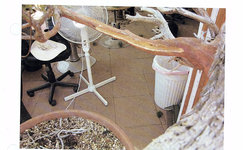parhamr
Omono
Scott Elser has done this to mountain hemlock! I have only heard him describe the technique but haven’t seen it visually so I’m not quite sure I know the nuts and bolts.Does anyone have direct knowledge of the success of wedge cuts in mountain hemlock?
in my case its a 3” trunk, nursery stocked Ive had in a grow box for a year. i have lots of height leverage to work with that will be coming off later.
It sounds like he removes a section and then bends around it. I couldn’t quite tell if he was removing from the “face” of the trunk (along the vertical grain) or “inside” the core of the wood, like a captured empty space. I might have misunderstood one of his metaphors or similes.
I think your plan is ideal. Go for it!
p.s. BSOP has some metalworking production plans afoot. If you’re up for it I’ll put you down as a possible contributor.








